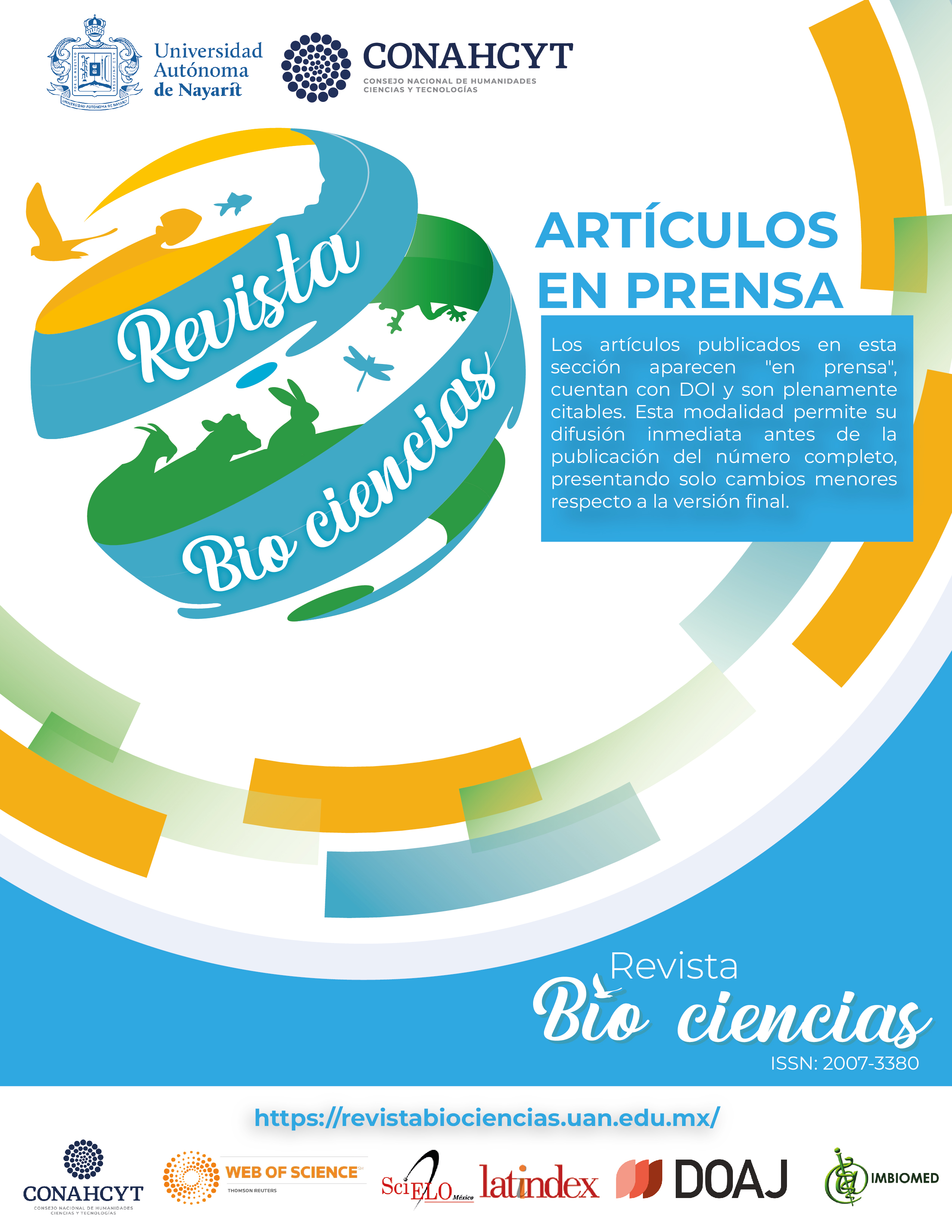Abstract
The scarcity of water for irrigation is affecting wheat production in Mexico, so it is necessary to select more efficient genotypes with water use. The objective was to evaluate the grain yield and its components of seven durum wheat genotypes under three irrigation regimes during the 2021-2022 and 2022-2023 autumn-winter cycles. Five varieties and two experimental lines were evaluated under three gravity irrigation schedules (2, 3 and 4 relief irrigations). A completely randomized design with three repetitions was used. The sheets applied for two, three and four relief irrigations were 49.5, 63.4 and 72.5 cm respectively. A significant difference (P ≤ 0.05) was found for grain yield between humidity regimes. With four aids a yield of 8,483 kg ha-1 was obtained, with three aids 7,709 kg ha-1 and with two aids the yield was 6,646 kg ha-1. The STOT line presented the highest grain yield, as did the TARRO line and the Noroeste C2021 variety, although the latter two presented a similar yield (P ≤ 0.05) to the rest of the materials. Hectoliter weight presented the greatest correlation with grain yield.
References
Ayed, S., Rezgui, M., Othmani, A., Rezgui, M., Trad, H., Silva, J. A., & Kharrat, M. (2017). Respuesta al estrés hídrico de trigos duros (Triticum turgidum ssp. durum) y harineros (Triticum aestivum L.) de Túnez. Agrociencia, 51(1), 13-26.
Ataei, M. (2006). Path analysis of barley (Hordeum vulgare L.) yield. Tarim Bilimleri Degisi. Ankara University Fakultesi. 12(3), 227-232.
Beche, E., Benin G., Da-Silva, C. L., Munaro, L. B., & Marchese, J. A. (2014). Genetic gain in yield and changes associated with physiological traits in Brazilian wheat during the 20th century. European Journal of Agronomy, 61, 49-59.
Buenrostro, R. J. F., Covarrubias, P. J., Solís, M. E., Ledesma, R. L., Cervantes, O. F., Mandujano, B. A., & Gámez, V. A. J. (2022). Impactos del ambiente y riego restringido en el rendimiento de grano de trigo en Guanajuato, México. Revista fitotecnia mexicana, 45(1), 65-73. https://doi.org/10.35196/rfm.2022.1.65
Blum, A. (2011). Drought tolerance: Is it a complex trait? Functional Plant Biology, 38(10), 753–757. https://doi.org/10.1071/FP11101
Blum, A. (2002). Drought tolerance is it a complex trait? In Field Screening for Drought Tolerance in Crop Plants with Emphasis on Rice. Edited by Saxena , N.P. and O’Toole , J.C. pp. 17-22. International Workshop on Field Screening for Drought Tolerance in Rice. ICRISAT, Patancheru, India.
Comisión Nacional del Agua [CONAGUA]. (2024). Normales climatológicas por estado (1981-2020). Servicio Meteorológico Nacional, Comisión Nacional del Agua. Ciudad de México. https://smn.conagua.gob.mx/es/climatologia/informacion-climatologica/normales-climatologicas-por-estado (Agosto 2024)
Espitia, R. E., Martínez, C. E., Villaseñor, M. H. E., Hortelano S. R. R., Limón, O. A., & Lozano G. A. (2021). Variabilidad genética y criterios de selección del rendimiento y los componentes en trigos harineros de temporal. Revista Mexicana de Ciencias Agrícolas, 12(2), 305-315. https://doi.org/10.29312/remexca.v12i2.2787
Gizaw, S. A., Garland, C. K., & Carter, A. H. (2016). Evaluación de características agronómicas y reflectancia espectral en trigo de invierno del noroeste del Pacífico en condiciones de secano y riego. Field Crops Research, 196(9), 168-179. https://doi.org/10.1016/j.fcr.2016.06.018
Kaur, V., & Behl, R. K. (2010). Grain yield in wheat as affected by short periods of high temperature, drought and their interaction during pre- and post-anthesis stages. Cereal Research Communications, 38, 514-520. https://doi.org/10.1556/CRC.38.2010.4.8
Lan, P. L., Zhen, W. Y., Dong, W., Yong, L. Z., & Shi, Y. (2011). Effects of Plant Density and Soil Moisture on Photosynthetic Characteristics of Flag Leaf and Accumulation and Distribution of Dry Matter in Wheat’’. Acta Agronómica Sinica, 37(6), 1049¬-1059. https://doi.org/10.1016/S1875-2780(11)60030-8
Lavilla, M. (2022). Efecto sobre el rendimiento del trigo (Triticum aestivum L.) de la roya amarilla causada por Puccinia striiformis f. sp. tritici. Agronomía Mesoamericana, 33(1), 7. https://www.scielo.sa.cr/pdf/am/v33n1/2215-3608-am-33-01-00013.pdf
Ledesma, R. L., Solís, M. E., Suaste, F. M. D. P., & Rodríguez, G. M. F. (2010). Relación de métodos de labranza, siembra, riego y dosis de nitrógeno con el rendimiento de trigo. Revista mexicana de ciencias agrícolas, 1(1), 55-63. https://www.scielo.org.mx/pdf/remexca/v1n1/v1n1a6.pdf
Martínez, C. E., Espitia, R. E., Villaseñor, M.H. E., & Hortelano, S. R. R. (2020). La productividad del trigo harinero bajo diferentes condiciones de riego. Revista mexicana de ciencias agrícolas, 11(6), 1349-1360. https://doi.org/10.29312/remexca.v11i6.2050
Martín, G. O., Agüero, S.N., Vera, J.T., Nicosia, M.G., Fernández M. M., & Lucas J. (2011). Componentes del rendimiento y productividad, de trigo cultivado en secano en la llanura subhúmeda-húmeda de Tucumán. Avances en la Producción Vegetal y Animal del NOA, 2011, 332-337.
Madani, A., Rad, A. S., Pazoki, A., Nourmohammadi, G., & Zarghami, R. (2010). Respuestas del llenado de grano y la distribución de materia seca del trigo (Triticum aestivum L.) a modificaciones de la fuente: sumidero bajo deficiencia de agua y nitrógeno postantesis. Acta Scientiarum. Agronomía, 32, 145-151. https://doi.org/10.4025/actasciagron.v32i1.6273
Mendoza, P. C., Sifuentes, I. E., Ojeda, B. W., & Macías, C. J. (2016). Respuesta del maíz de riego superficial al riego deficitario regulado. Ingeniería agrícola y biosistemas, 8(1), 29-40. https://doi.org/10.5154/r.inagbi.2016.03.001
Miranda, D. L. E., López, C. C., Benítez, R. I., & Mejía C. J. A. (2016). Desarrollo radical y rendimiento en diferentes variedades de trigo, cebada y triticale bajo condiciones limitantes de humedad del suelo. Terra Latinoamericana, 34(4), 393-407. https://www.scielo.org.mx/scielo.php?pid=S0187-57792016000400393&script=sci_arttext
Neri, J. C., Huaman, H. E., Collazos, S. R., Oliva, M., & Ix-Balam, M. A. (2021). Influencia del estrés por déficit hídrico sobre el rendimiento de cultivo de trigo (Triticum aestivum L.). Revista De Investigación De Agroproducción Sustentable, 5(1), 73-79. https://doi.org/10.25127/aps.20211.762
Ojeda, B. W., Sifuentes, I. E., & Unland, W. (2006). Programación integral del riego en maíz en el norte de Sinaloa. Agrociencia, 40, 13 - 25. http://187.174.234.55/bitstream/handle/20.500.12013/1736/OT_086.pdf?sequence=1&isAllowed=y
Paquini, R. S. L., Benítez, R. I., Villaseñor, M. H. E., Muñoz, O. A., & Vaquera, H. H. (2016). Incremento en el rendimiento y sus componentes bajo riego normal y restringido de variedades mexicanas de trigo. Revista fitotecnia mexicana, 39(4), 367-378. https://www.scielo.org.mx/scielo.php?pid=S0187-73802016000400367&script=sci_arttext
Pietragalla, J. & Pask, A. J. D. (2013). Rendimiento de grano y componentes del rendimiento. In: fitomejoramiento fisiológico II: una guía de campo para la caracterización fenotípica de trigo. Pask, A. J. D.; Pietragalla, J.; Mullan, D. M.; Chávez-Dulanto, P. N. y Reynolds, M. P. (Eds.). Centro Internacional de Mejoramiento de Maíz y Trigo (CIMMYT). México, D. F.95-103 pp.
Rosabal, A. L., Martínez, G. L., Reyes, G. Y., Dell’Amico, R. J., & Núñez, V. M. (2014). Aspectos fisiológicos, bioquímicos y expresión de genes en condiciones de déficit hídrico. Influencia en el proceso de germinación. Cultivos Tropicales, 35(3), 24-35. http://scielo.sld.cu/scielo.php?pid=S0258-59362014000300003&script=sci_arttext&tlng=pt
Robles, C. A. A. (2007). Sobrevivir al estrés: cómo responden las plantas a la falta de agua. Biotecnología, 14, 253-262. https://www.researchgate.net/profile/Alejandra-Covarrubias/publication/268000327_Sobrevivir_al_estres_como_responden_las_plantas_a_la_falta_de_agua/links/548b191d0cf2d1800d7db185/Sobrevivir-al-estres-comoresponden-las-plantas-a-la-falta-de-agua.pdf
Red de Estaciones Meteorológicas Automáticas de Sonora [REMAS]. (2024). Red de Estaciones Meteorológicas Automáticas de Sonora. www.siafeson.com/remas
Sadras, V. O., & McDonald, G. (2012). Water use efficiency of grain crops in Australia: principles, benchmarks and management. Change, 11 (19), 24.
Salinas Z. C. A., Lluch B. D., Hernández V. S., & Lluch C. D.B. (1998). La aridez en el noreste de México. Un análisis de su variabilidad espacial y temporal. Atmósfera, 11(1), 29-44.
Servicio de Información Agroalimentaria y Pesquera [SIAP]. (2023). Anuario estadístico de la producción agrícola. Servicio de Información Agroalimentaria y Pesquera. Ciudad de México. https://www.gob.mx/siap
Servicio de Información Agroalimentaria y Pesquera [SIAP]. (2024). Anuario estadístico de la producción agrícola. Secretaria de Agricultura y Desarrollo Rural. Ciudad de México. https://www.gob.mx/siap
Sánchez, B. M. (2009). Bases para el manejo de aguas en zonas infradotadas. Relación agua-suelo-planta. AECID. Mundo Prensa. Madrid, 43-63.
SAS Institute (2011). SAS/STAT Versión 9.3 User´s Guide. SAS Institute, Inc. Cary, North Carolina, USA. 8621.
Solís, M, E., J. Huerta, E. J., Villaseñor, M. H. E., Pérez, H. P., Ramírez, R. A., Ledesma, R.L., & Cruz, G. M. L. (2013). Luminaria F2012, nueva variedad de trigo harinero para riego restringido en El Bajío. Revista mexicana de ciencias agrícolas, 5(2), 325-330. https://www.scielo.org.mx/pdf/remexca/v5n2/v5n2a13.pdf
Sifuentes, I. E., Ojeda, B. W., Macias, C. J., Mendoza, P. C., & Preciado, R. P. (2021). Déficit hídrico en maíz al considerar fenología, efecto en rendimiento y eficiencia en el uso del agua. Agrociencia, 55(3), 209-226. https://doi.org/10.47163/agrociencia.v55i3.2414
Shamsi, K., & Kobraee, S. (2011) Bread wheat production under drought stress conditions. Annals of Biological Research 2, 352-358. http://scholarsresearchlibrary.com/ABR-vol2-iss3/ABR-2011-2-3-352-358.pdf
Thapa, S., Xue, Q., Jessup, K. E., Rudd, J. C., Liu, S. Y., Marek, T. H., Devkota, R. N., Baker, J. A., & Baker, S. (2019). Yield determination in winter wheat under different water regimes. Field Crops Research, 233(3), 80-87. https://doi.org/10.1016/j.fcr.2018.12.018
Ul, A. S., Iqbal, M., Maqsood, S., Naeem, M., Ijaz, M., Ashfaq, W., & Hussain, M. (2018). Improving the performance of bread wheat genotypes by managing irrigation and nitrogen under semi-arid conditions. Archives of Agronomy and Soil Science, 64(12), 1678-1689. https://doi.org/10.1080/03650340.2018.1450974
Valdés, V. C., Estrada, C. G., Martínez, R. C. G., & Domínguez, L. A. (2017). Rendimiento de grano en trigo modificado por cambios en la fuente durante el llenado de grano. Revista Mexicana de Ciencias Agrícolas, 8(1), 79-90. https://www.scielo.org.mx/scielo.php?pid=S2007-09342017000100079&script=sci_arttext
Xu, X., Zhang, M., Li, J., Liu, Z., Zhao, Z., Zhang, Y., Zhou, S., & Wang, Z. (2018). Improving water use efficiency and grain yield of winter wheat by optimizing irrigations in the North China Plain. Field Crops Ressearch. 221(5), 219-227. https://doi.org/10.1016/j.fcr.2018.02.011
Zarazúa V. P., Ruiz C. J. A., González E. D. R., Flores L. H. E., & Ron P. J. (2011). Cambio climático y agroclimático para el ciclo otoño-invierno en la región Ciénega de Chapala. Revista mexicana de ciencias agrícolas, 2295-308. http://www.scielo.org.mx/scielo.php?script=sci_arttext&pid=S200709342011000800010&lng=es&tlng=es
Zhou, B., Sanz, S. Á., Elazab, A., Shen, T., Sánchez, B. R., Bort, J., Serret, M. D., & Araus, J. L. (2014). Physiological traits contributed to the recent increase in yield potential of winter wheat from Henan Province, China. Journal of integrative plant biology, 56(5), 492-504. https://doi.org/10.1111/jipb.12148

Revista Bio Ciencias by Universidad Autónoma de Nayarit under Creative Commons Attribution-NonCommercial 3.0 Unported License.
Based on work of http://biociencias.uan.edu.mx/.
Further permits not covered by this licence can be found at http://editorial.uan.edu.mx/index.php/BIOCIENCIAS.






